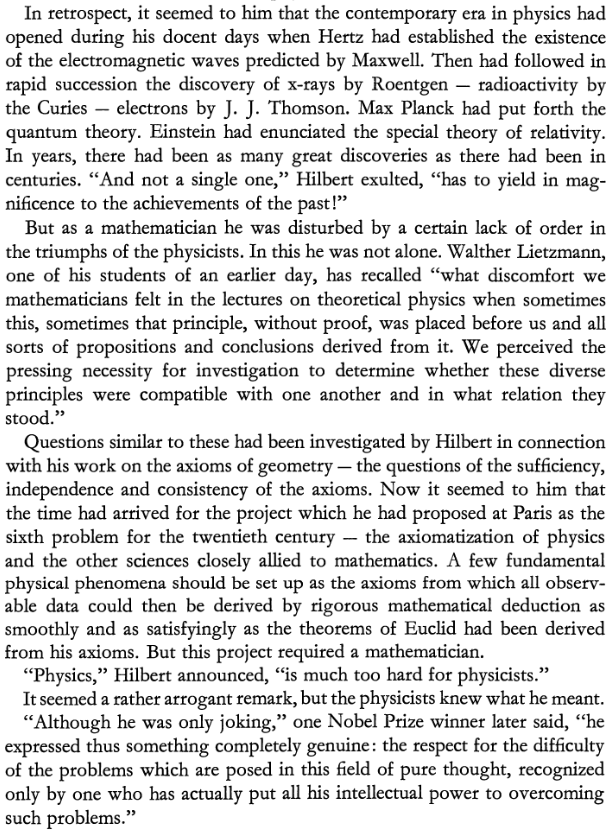nLab Hilbert's sixth problem
Context
Physics
physics, mathematical physics, philosophy of physics
Surveys, textbooks and lecture notes
theory (physics), model (physics)
experiment, measurement, computable physics
-
-
-
Axiomatizations
-
Tools
-
Structural phenomena
-
Types of quantum field thories
-
Mathematics
-
-
- geometry (general list), topology (general list)
- general topology
- differential topology
- differential geometry
- algebraic geometry
- noncommutative algebraic geometry
- noncommutative geometry (general flavour)
- higher geometry
Foundations
The basis of it all
Set theory
- fundamentals of set theory
- material set theory
- presentations of set theory
- structuralism in set theory
- class-set theory
- constructive set theory
- algebraic set theory
Foundational axioms
-
basic constructions:
-
strong axioms
-
further
Removing axioms
Contents
Statement
The sixth in the famous list of Hilbert's problems asks for the formalization/axiomatization of physics in mathematics. The original version in the way Hilbert stated it (Hilbert 1901) is the following (translated from the original German):
6. Mathematical Treatment of the Axioms of Physics. The investigations on the foundations of geometry suggest the problem: To treat in the same manner, by means of axioms, those physical sciences in which already today mathematics plays an important part; in the first rank are the theory of probabilities and mechanics. (full text)
Reid 1970 p 127 recalls Hilbert’s motivation as follows:

Further discussion of background and historical context is given by the ICM06 speech of Corry 2006, where it says:
From all the problems in the list, the sixth is the only one that continually engaged [Hilbert’s] efforts over a very long period, at least between 1894 and 1932.
Hence not the least due to Hilbert himself, meanwhile of course several aspects of physics have been formalized, while others are certainly still waiting to be understood in a systematic fashion.
Hilbert’s original example of probability theory is considered to be fully axiomatized since the 1930s by the concepts of measure theory. For the example of mechanics the status of the axiomatization crucially depends on how widely one understands the term today. The special case of classical mechanics which Hilbert was origially referring to has been fully formalized by means of symplectic geometry and variational calculus. Hilbert himself then contributed to the application of this formalization to gravity (“Einstein-Hilbert action”, see Sauer 99) and the formalization of the refinement of classical mechanics to quantum mechanics (“Hilbert space”). Even though to this day the ontological status of quantum mechanics as a theory of physics is the topic of debates, certainly the mathematics of quantum mechanics as such is fully captured by functional analysis and operator algebra theory. But this situation changes drastically when one passes to what since around the 1950s is understood to be the more fundamental and general version of mechanics in nature, namely quantum field theory. Since the 1960 the Haag-Kastler axioms (“AQFT”) have been proposed as an axiomatization for quantum field theory and crucially for local quantum field theory. While these axioms had some success in laying a foundation for structural results such as the PCT theorem, their continuing lack of relevant examples (models) in dimensions greater than 2 seems to indicate that something is missing. Modern developments in higher algebra and higher geometry suggest that a refinement of the axioms to the context of homotopy theory is necessary and natural.
Related pages
Related expositions:
References
The original list of Hilbert's problems appears in
- David Hilbert, Mathematical Problems, Bulletin of the American Mathematical Society, vol. 8, no. 10 (1902), pp. 437-479. Earlier publications (in the original German) appeared in Göttinger Nachrichten, 1900, pp. 253-297, and Archiv der Mathematik und Physik, 3dser., vol. 1 (1901), pp. 44-63, 213-237. (AMS, pdf, html)
The historical context of the sixth problem is recalled by
- Constanze Reid, around p. 127 of: Hilbert, Springer (1970) [doi:10.1007/978-3-662-28615-9]
and in some detail in
-
Leo Corry, David Hilbert and the axiomatization of physics: From Grundlagen der Geometrie to Grundlagen der Physik, Archimedes: New Studies in the History and
Philosophy of Science and Technology 10, Kluwer Academic Publishers (2004) [pdf]
-
Leo Corry, On the origins of Hilbert’s sixth problem: physics and the empiricist approach to axiomatization, Proceedings of the International Congress of Mathematics in Madrid 2006 [pdf]
Hilbert’s own work on the foundations of the classical field theory of gravity (general relativity) is surveyed in
- Tilman Sauer: The relativity of discovery: Hilbert’s first note on the foundations of physics, Arch. Hist. Exact Sci. 53 6 (1999) 529-575 [arXiv:physics/9811050]
Discussion in the context of higher category theory and physics:
- Yuri Ximenes Martins, Rodney Josué Biezuner, Towards An Approach to Hilbert’s Sixth Problem: A Brief Review, 2020 (hal:02909681, pdf)
Surveys of the sixths problem include
- Wikipedia, Hilbert’s sixth problem
Last revised on September 24, 2024 at 10:45:38. See the history of this page for a list of all contributions to it.